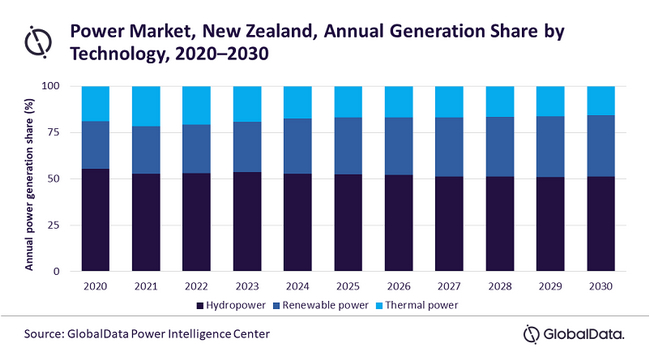Hydropower in New Zealand held a share of 55.6% in 2020 in its total annual power generation. However, this share is expected to marginally decline to 51.1% in 2030. Still, the hydropower generation in the country will continue to hold the dominant share in its generation mix till 2030, forecasts GlobalData, a leading data and analytics company.
GlobalData’s report, ‘New Zealand Power Market Outlook to 2030, Update 2021 – Market Trends, Regulations, and Competitive Landscape’, reveals that the installed hydropower capacity increased marginally from 5.2 GW in 2000 to 5.43 GW in 2020, growing at a compound annual growth rate (CAGR) of 0.2%. By 2030, the installed hydropower capacity will witness negligible growth to reach 5.44 GW, growing at a CAGR of 0.01% from 2020 to 2030. Even though the capacity additions are negligible, huge installed hydropower capacity means that hydropower will continue to lead power generation in New Zealand till 2030.

Rohit Ravetkar, Power Analyst at GlobalData, says: “Hydropower is the major source of power generation in New Zealand. Majority of the hydropower plants are in the South Island of the country. Electricity generated from hydropower sources in the South Island is then transported to the North Island through high voltage transmission lines. The country has already expanded its large conventional hydro capacity and future additions will be minimal and limited to small hydro plants.”
Majority of the hydropower plants in New Zealand are run-of-the-river schemes which can store electricity only for a few hours or days after generation. To enable the storage of this generated electricity, in July 2020, the government earmarked US$30m for the research and development of pumped hydro storage in the country.
Ravetkar concludes: “High dependence on hydropower generation is a major challenge for New Zealand’s supply security. With the country not having nuclear power and it being not keen on expanding its thermal power capacity, the country may look towards the rapid development of renewable sector to reduce its dependence on hydropower.
“For this, the government has rolled out several incentive programs and subsidies in the form of tax reliefs, capital cost grants and favorable power tariffs for renewable power. This is expected to result in rapid growth of the renewable sector with the renewable capacity growing at a CAGR of 5.6% from 2.24 GW in 2020 to 3.88 GW in 2030.”
- Comments provided by Rohit Ravetkar, Industry Analyst at GlobalData
- Information based on GlobalData’s report New Zealand Power Market Outlook to 2030, Update 2021 - Market Trends, Regulations, and Competitive Landscape
- This press release was written using data and information sourced from proprietary databases, primary and secondary research, and in-house analysis conducted by GlobalData’s team of industry experts
About GlobalData
4,000 of the world’s largest companies, including over 70% of FTSE 100 and 60% of Fortune 100 companies, make more timely and better business decisions thanks to GlobalData’s unique data, expert analysis and innovative solutions, all in one platform. GlobalData’s mission is to help our clients decode the future to be more successful and innovative across a range of industries, including the healthcare, consumer, retail, technology, energy, financial and professional services sectors.
